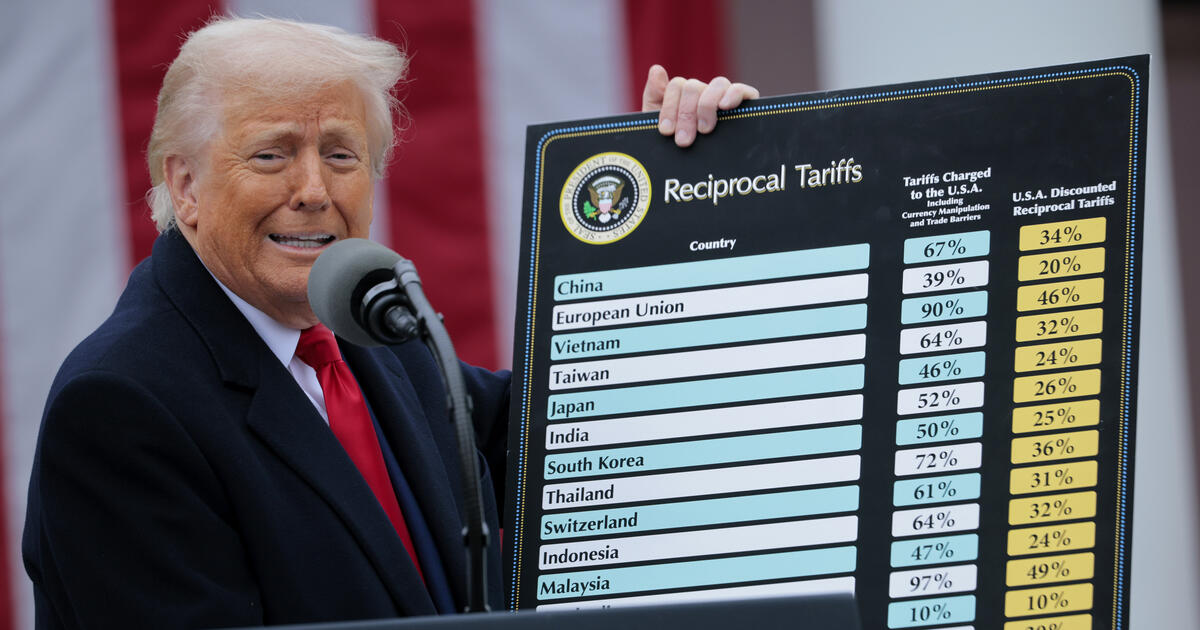On April 2, 2025, President Trump announced the implementation of tariffs on just about every country on Earth, with the minimum tariff being 10% and with some countries receiving as high as 50% tariffs. By the morning of April 3rd, the markets were in a downturn, with the Dow Jones and the S&P 500 sliding down thousands of points.
For a reminder of what tariffs exactly do, here’s a helpful article.
Let’s examine why the tariffs were implemented, their potential causes, and where we go from here:
How the Tariffs Work
Prior to the tariffs, the president had already implemented several tariff policies including duties on steel and aluminum products, and specific tariffs on Canada, China, and Mexico. An additional 25% tariff on foreign automobiles had also been announced to take effect at midnight on April 3rd. As a result of these policies, the average U.S. tariff rate is now approximately 12% – the highest rate since the Second World War.
In his speech from the White House Rose Garden, Trump declared April 2nd as “Liberation Day” and announced a two-tiered tariff structure: (a) a baseline 10% tariff applied universally to every single country except for Canada and Mexico and (b) 60 additional country-specific “reciprocal” tariffs based on what his administration deemed as unfair trade practices. The baseline tariffs would take effect at 12:01 AM EST on April 5th while the reciprocal tariffs would take effect at 12:01 AM EST on April 9th. President Trump said that he intended for the tariffs to boost domestic production and create jobs.
Here are charts of all the tariffs that would be implemented:
Source: The White House
There are several things to note. The White House has confirmed that the 34% retaliatory tariffs being implemented on China would be applied in addition to the already existing 20% tariffs, meaning that there would be an overall 54% tariff on China. Products already impacted by previously-implemented tariffs (steel, aluminum, and vehicles) would not be subject to these tariffs, including energy products and certain minerals “not available in the United States.” In the charts, there are also several territories that receive tariffs that are different than the tariffs being imposed on the country that owns them. For instance, the island of Reunion is receiving a 37% retaliatory tariff while its owner, France, is getting a 20% retaliatory tariff along with the rest of the EU. Another similar scenario can be seen with Australia’s Norfolk Island, an island of around 2,000 people which is receiving a 29% tariff while Australia itself only gets a 10% tariff. Perhaps the most absurd situation is the Heard and McDonald Islands, an uninhabited Australian territory near Antarctica whose only inhabitants are penguins.
Now, how did the Trump administration calculate the amount of tariffs? Here’s the formula that the US Trade Representative and the White House have said that they used:
Source: Office of the United States Trade Representative, annotated by Axios
Moving past all the Greek lettering that the Trump administration put in there to make it look smart, the formula is simply the difference between a country’s exports to the U.S. and a country’s imports from the U.S. divided by ε (meaning 4) times φ (meaning 0.25) times the total imports. The letter “i” in the equation means any country, so one can disregard that. 4 times 0.25 is 1, so that doesn’t really matter in this equation. Essentially, the higher the deficit in relation to imports from the United States, the higher the reciprocal tariff imposed on the country. It also just so happens that ChatGPT comes up with this same formula if you ask it to come up with a tariff on another country to set the balance of trade to zero. This means it is certainly possible that Trump’s team used ChatGPT to come up with these tariffs.
The Trump administration is not reciprocating tariffs. Rather, it is just placing the biggest tariffs on countries running the biggest trade surpluses with the United States. The tariffs are confusing to America’s trade partners. They particularly punish poor countries that cannot afford to import U.S. goods, as seen with the tiny southern African nation of Lesotho receiving the highest retaliatory tariff (50%). The formula may seem fair, but it is just going to lead to more economic efficiency overall.
Effects of the Tariffs
So, this brings us to the question: how will the tariffs affect everything?
Let’s start with the good. The tariffs could possibly lead to favorable negotiations for the U.S. due to their threat to other countries’ economies. They could bring back jobs to the United States due to the shift of production, with a possible revival in manufacturing (although recent polls have shown that young people are less likely to work in manufacturing). The tariffs could raise domestic prices thereby helping local industry in the United States.
However, the tariffs also come with their negative side. For starters, the prices of everything foreign-made in the United States will go higher. China has a 54% retaliatory tariff on their products, which the U.S. has a lot of. iPhones made in China and whose components come from other countries also facing high tariffs will see their prices skyrocket to the thousands. Clothing made in Bangladesh (which has a 37% retaliatory tariff) and Vietnam (which has a 46% tariff) will become more expensive. Nearly 70% of all shoes the U.S. imports are from China and Vietnam. Semiconductors made in Taiwan (which has a 32% retaliatory tariff) will get more expensive. The foods that the U.S. imports from Africa and South America will get more expensive. Practically everything will get more expensive for the average American consumer. This is the largest peacetime tax hike ever on the American consumer, with Americans now projected to pay around $1 trillion in tariffs per year. Poverty levels in the U.S. would shoot up.
The tariffs will lead to unnecessary trade wars, which are generally harmful in the long run and lead to higher prices, supply chain disruptions, and strained international relations. The tariffs that the U.S. imposes on their allies (the EU, the UK, Japan, etc.) may cause them to become closer to China and therefore chip away at the system of U.S. hegemony that has been well-established for the last eighty or so years. America would be ceding its role as a leader in the global economy by carrying out this rogue act.
These economic disruptions have the strong potential to threaten the interconnected global economy. The world has become so interconnected that with the implementation of these tariffs and the possible retaliation by other countries, the economies of many countries including the U.S. itself are poised to fall into a recession and a financial crisis.
What Comes Next?
It remains to be seen whether or not the tariffs will fully push through. So far, the Trump administration is defending the tariffs and remaining firm. Some countries, like Vietnam, are attempting to negotiate with the Trump administration. Others are choosing to retaliate, with China imposing a 34% tariff on U.S. goods. As such, stock markets around the globe have been in a rout, with the Dow Jones, S&P 500, and the Nasdaq losing thousands of points on Thursday and Friday. The prominent financial firm JPMorgan is now projecting a recession later this year.
If the Liberation Day tariffs do go into effect, their consequences have the potential to destroy whatever credibility the Trump administration has left on economic affairs. The president had run on a platform of lowering prices for the consumer. Now, he is poised to increase those prices. If the tariffs situation goes poorly, the political consequences for Trump’s Republican Party in the 2026 midterm elections and beyond may well be devastating.
Emil Ordonez, a rising college freshman, is the founder and editor-in-chief of Polinsights. He has been deeply passionate about politics and history since learning every U.S. President at the age of five. He was compelled to start this blog after meeting many people who were misinformed or had become apathetic about how society worked. He hopes to provide factual knowledge and insights that will encourage people, especially the young, to get more engaged in their respective communities. In his free time, he edits for Wikipedia and makes maps for elections. He aspires to work in Congress or even the White House in the future.


Leave a Reply